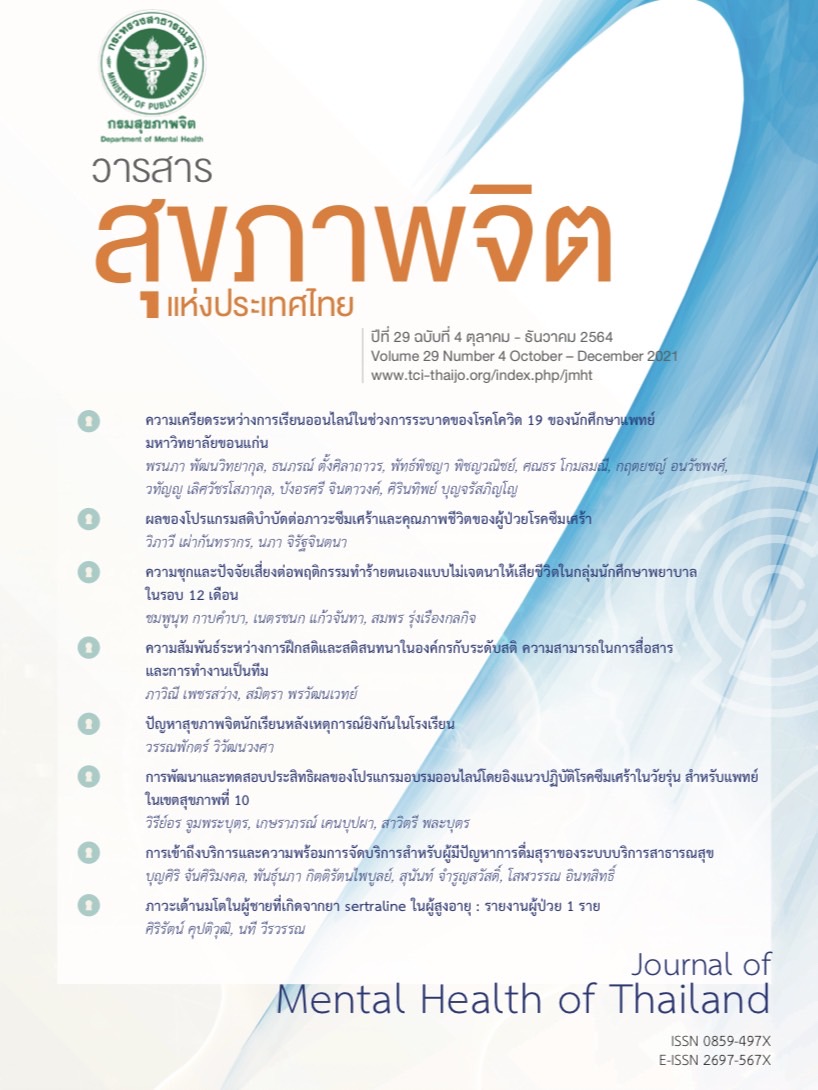ความชุกและปัจจัยเสี่ยงต่อพฤติกรรมทำร้ายตนเองแบบไม่เจตนาให้เสียชีวิตในกลุ่มนักศึกษาพยาบาล ในรอบ 12 เดือน
คำสำคัญ:
ความชุก, นักศึกษาพยาบาล, พฤติกรรมทำร้ายตนเองแบบไม่เจตนาให้เสียชีวิตบทคัดย่อ
วัตถุประสงค์ : เพื่อศึกษาความชุกและปัจจัยเสี่ยงต่อพฤติกรรมทำร้ายตนเองแบบไม่เจตนาให้เสียชีวิตในกลุ่มนักศึกษาพยาบาลในช่วงเวลา 12 เดือนที่ผ่านมา
วิธีการ : เป็นการศึกษาเชิงพรรณนาแบบตัดขวาง กลุ่มตัวอย่างเป็นนักศึกษาพยาบาลศาสตรบัณฑิต จำนวน 141 คนเก็บรวบรวมข้อมูลแบบออนไลน์โดยใช้แบบสอบถามพฤติกรรมทำร้ายตนเองแบบไม่เจตนาให้เสียชีวิต และแบบสอบถามเหตุการณ์สำคัญในชีวิต วิเคราะห์ข้อมูลโดยใช้สถิติเชิงบรรยาย และวิเคราะห์ปัจจัยเสี่ยงต่อพฤติกรรมทำร้ายตนเองแบบไม่เจตนาให้เสียชีวิตด้วยวิธี multiple logistic regression นำตัวแปรเข้าแบบ enter method
ผล : ความชุกของพฤติกรรมทำร้ายตนเองแบบไม่เจตนาให้เสียชีวิตของนักศึกษาพยาบาลในช่วง 12 เดือนที่ผ่านมาเท่ากับร้อยละ 31.9 (95% CI = 24.8 - 40.4) ปัจจัยเสี่ยงต่อพฤติกรรมทำร้ายตนเองแบบไม่เจตนาให้เสียชีวิตของนักศึกษาพยาบาลในช่วง 12 เดือนที่ผ่านมา คือ ปัญหาด้านการเงิน (OR = 4.60, 95% CI = 1.16 - 13.15)
สรุป : นักศึกษาพยาบาลประมาณ 1 ใน 3 มีพฤติกรรมทำร้ายตนเองแบบไม่เจตนาให้เสียชีวิต และการประสบปัญหาด้านการเงินมีความสัมพันธ์อย่างมีนัยสำคัญกับพฤติกรรมทำร้ายตนเองแบบไม่เจตนาให้เสียชีวิต อย่างไรก็ตาม เนื่องจากการศึกษานี้เก็บข้อมูลด้วยการรายงานด้วยตนเอง ซึ่งอาจทำให้ผลการวิจัยมีอิทธิพลจากการมีแนวโน้มที่จะตอบในแบบที่สังคมยอมรับได้ ดังนั้นการนำผลการวิจัยไปใช้ควรคำนึงถึงอิทธิพลจากปัจจัยดังกล่าว
Downloads
เอกสารอ้างอิง
สมบูรณ์ หทัยอยู่สุข, สุพร อภินันทเวช. การฆ่าตัวตายของวัยรุ่นในประเทศไทย : อุบัติการณ์ สาเหตุ และการป้องกัน [Adolescent suicide in Thailand: incidence, causes and prevention]. เวชบันทึกศิริราช. 2563;13(1):40-7.
Gholamrezaei M, Heath N, Panaghi L. Non-suicidal self-injury in a sample of university students in Tehran, Iran: prevalence, characteristics and risk factors. Int J Cult Ment Health. 2016;10(2):136-49. doi:10.1080/17542863.2016.1265999.
Olfson M, Wall M, Wang S, Crystal S, Bridge JA, Liu SM, et al. Suicide after deliberate self-harm in adolescents and young adults. Pediatrics. 2018;141(4):e20173517. doi:10.1542/peds.2017-3517.
Castellví P, Lucas-Romero E, Miranda-Mendizábal A, Parés-Badell O, Almenara J, Alonso I, et al. Longitudinal association between self-injurious thoughts and behaviors and suicidal behavior in adolescents and young adults: a systematic review with meta-analysis. J Affect Disord. 2017;215:37-48. doi:10.1016/j.jad.2017.03.035.
Gillies D, Christou MA, Dixon AC, Featherston OJ, Rapti I, Garcia-Anguita A, et al. Prevalence and characteristics of self-harm in adolescents: meta-analyses of community-based studies 1990–2015. J Am Acad Child Adolesc Psychiatr. 2018;57(10):733-41. doi:10.1016/j.jaac.2018.06.018.
Lim KS, Wong CH, McIntyre RS, Wang J, Zhang Z, Tran BX, et al. Global lifetime and 12-month prevalence of suicidal behavior, deliberate self-harm and non-suicidal self-injury in children and adolescents between 1989 and 2018: a meta-analysis. Int J Environ Res Pu. 2019;16(22):4581. doi:10.3390/ijerph16224581.
Cipriano A, Cella S, Cotrufo P. Nonsuicidal self-injury: a systematic review. Front Psychol. 2017;8:1946. doi:10.3389/fpsyg.2017.01946.
Tang J, Yang W, Ahmed NI, Ma Y, Liu H-Y, Wang J-J, et al. Stressful life events as a predictor for non-suicidal self-injury in southern Chinese adolescence: a cross-sectional study. Medicine (Baltimore). 2016;95(9):e2637. doi:10.1097/MD.0000000000002637.
van der Walt F. Self-harming behaviour among university students: a South African case study. J Psychol Afr. 2016;26(6):508-12. doi:10.1080/14330237.2016.1250420.
Sivertsen B, Hysing M, Knapstad M, Harvey AG, Reneflot A, Lønning KJ, et al. Suicide attempts and non-suicidal self-harm among university students: prevalence study. BJPsych Open. 2019;5(2):e26. doi:10.1192/bjo.2019.4.
Huang YH, Liu HC, Sun FJ, Tsai FJ, Huang KY, Chen TC, et al. Relationship between predictors of incident deliberate self-harm and suicide attempts among adolescents. J Adolesc Health. 2017;60(5):612–8. doi:10.1016/j.jadohealth.2016.12.005.
สุภาวดี เจริญวานิช. Self-Cyberbullying: มิติใหม่ของการทำร้ายตนเองในวัยรุ่น [Self-cyberbullying: new way of self-harm in adolescents]. วารสารวิทยาศาสตร์และเทคโนโลยี. 2562;27(6):1099-105.
Hooley JM, St. Germain SA. Nonsuicidal self-injury, pain, and self-criticism: does changing self-worth change pain endurance in people who engage in self-injury?. Clin Psychol Sci. 2014;2(3):297-305. doi:10.1177/2167702613509372.
Uh S, Dalmaijer ES, Siugzdaite R, Ford TJ, Astle DE. Two pathways to self-harm in adolescence. J Am Acad Child Adolesc Psychiatry. 2021:S0890-8567(21)00219-7. doi:10.1016/j.jaac.2021.03.010.
Bennardi M, McMahon E, Corcoran P, Griffin E, Arensman E. Risk of repeated self-harm and associated factors in children, adolescents and young adults. BMC Psychiatry. 2016;16(1):421. doi:10.1186/s12888-016-1120-2.
Wu D, Rockett RHI, Yang T, Feng X, Jiang S, Yu L. Deliberate self-harm among Chinese medical students: a population-based study. J Affect Disord. 2016;202:137-44. doi:10.1016/j.jad.2016.05.030.
Cully G, Corcoran P, Leahy D, Griffin E, Dillon C, Cassidy E, Shiely F, Arensman E, et al. Method of self-harm and risk of self-harm repetition: findings from a national self-harm registry. J Affect Disord. 2019;246:843-50. doi:10.1016/j.jad.2018.10.372.
Borrill J, Fox P, Roger D. Religion, ethnicity, coping style, and self-reported self-harm in a diverse non-clinical UK population. Mental Health, Religion & Culture. 2011;14(3):259–69. doi:10.1080/13674670903485629.
Benjet C, Gutiérrez-García RA, Abrego-Ramírez A, Borges G, Covarrubias-Díaz A, Durán MDS, et al. Psychopathology and self-harm among incoming first-year students in six Mexican universities. Salud Publica Mexico. 2019;61(1):16-26. doi:10.21149/9158.
Kumar A, Srivastava M, Srivastava M. A situational analysis of tendency of deliberate self-harm among students. Indian J Prev Soc Med. 2017;48(1–2):90-7.
Siu AMH. Self-Harm and suicide among children and adolescents in Hong Kong: a review of prevalence, risk factors, and prevention strategies. J Adolesc Health. 2019;64(6):S59-64. doi:10.1016/j.jadohealth.2018.10.004.
Wan Y, Chen J, Sun Y, Tao F. Impact of childhood abuse on the risk of non-suicidal self-injury in mainland Chinese adolescents. PLoS One. 2015;10(6):e0131239. doi:10.1371/journal.pone.0131239.
Guerreiro DF, Sampaio D, Figueira ML, Madge N. Self-harm in adolescents: a self-report survey in schools from Lisbon, Portugal. Arch Suicide Res. 2017;21(1):83–99. doi:10.1080/13811118.2015.1004480.
Aggarwal S, Patton G, Reavley N, Sreenivasan SA, Berk M. Youth self-harm in low- and middle-income countries: Systematic review of the risk and protective factors. IntT J Soc Psychiatr. 2017;63(4):359-75. doi:10.1177/0020764017700175.
Borschmann R, Becker D, Coffey C, Spry E, Moreno-Betancur M, Moran P, et al. 20-year outcomes in adolescents who self-harm: a population-based cohort study. Lancet Child Adolesc Health. 2017;1(3):195–202. doi:10.1016/S2352-4642(17)30007-X.
Abbasi NU, Raza A, Khurshid M, Ansari MI. The relationship between depression, anxiety, stress and self harm among college students: a cross-sectional survey. Pakistan Armed Forces Medical Journal. 2018;68(1):137-42.
Klonsky ED. The functions of self-injury in young adults who cut themselves: clarifying the evidence for affect-regulation. Psychiatry Res. 2009;166(2-3):260-8. doi:10.1016/j.psychres.2008.02.008.
Klonsky ED, Muehlenkamp JJ. Self-injury: a research review for the practitioner. J Clin Psychol. 2007;63(11):1045–56. doi:10.1002/jclp.20412.
Klonsky ED. The functions of deliberate self-injury: a review of the evidence. Clin Psycho Rev. 2007;27(2):226–39. doi:10.1016/j.cpr.2006.08.002.
Russell K, Allan S, Beattie L, Bohan J, MacMahon K, Rasmussen S. Sleep problem, suicide and self-harm in university students: a systematic review. Sleep Med Rev. 2019;44:58-69. doi:10.1016/j.smrv.2018.12.008.
กรมสุขภาพจิต. อัตราการฆ่าตัวตายแยกตามช่วงอายุ ประจำปี 2560 [Suicide rate by age group, 2017]. นนทบุรี: กรมสุขภาพจิต: 2561 [สืบค้นเมื่อวันที่ 30 ม.ค. 2563]. จาก: https://www.dmh.go.th/report/suicide/viewg1.asp?id=26
วรรณคล เชื้อมงคล, ปรีดา รุ่งรัตนพงษ์พร, สุรพงศ์ ฉันทะธัมมะ. ภาวะซึมเศร้าและความเสี่ยงต่อการคิดฆ่าตัวตายในนิสิตคณะเภสัชศาสตร์ มหาวิทยาลัยศรีนครินทรวิโรฒ [Depression and suicidal risk among pharmacy students at Srinakharinwirot University]. วารสารการแพทย์และวิทยาศาสตร์สุขภาพ. 2561;25(2):124-34.
สุกัญญา รักษ์ขจีกูล. ภาวะซึมเศร้าและพฤติกรรมการฆ่าตัวตายในนิสิตมหาวิทยาลัยนเรศวร [Depression and suicidal behaviors among Naresuan University students]. วารสารสมาคมจิตแพทย์แห่งประเทศไทย. 2556;58(4):359-70.
Sansone AR, Sansone AL. Measuring self-harm behavior with the self-harm inventory. Psychiatry (Edgmont). 2010;7(4):16–20.
ปุญญพัฒน์ ไชยเมล์. การกำหนดขนาดตัวอย่างสำหรับการวิจัยเชิงพรรณนาในงานสาธารณสุข [Sample size determination in descriptive study in public health]. วารสารมหาวิทยาลัยทักษิณ. 2556;16(2):9–18.
Brisln WR. Back-translation for cross-cultural research. J Cross Cult Psychol. 1970;1(3):185-216. doi:10.1177/135910457000100301.
ดาวน์โหลด
เผยแพร่แล้ว
รูปแบบการอ้างอิง
ฉบับ
ประเภทบทความ
สัญญาอนุญาต
- ผู้อ่านสามารถนำข้อความ ข้อมูล จากวารสารไปใช้ไปใช้ประโยชน์ทางวิชาการได้ เช่น เพื่อการสอน เพื่อการอ้างอิง แต่การนำไปใช้เพื่อวัตถุประสงค์อื่น เช่น เพื่อการค้า จะต้องได้รับอนุญาตเป็นลายลักษณ์อักษรจากกรมสุขภาพจิตก่อน
- ความคิดเห็น ข้อมูล และบทสรุปต่าง ๆ ที่ลงตีพิมพ์ในวารสารสุขภาพจิตแห่งประเทศไทยเป็นของผู้เขียนบทความและมิได้แสดงว่ากองบรรณาธิการหรือกรมสุขภาพจิตเห็นพ้องด้วย




